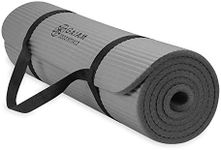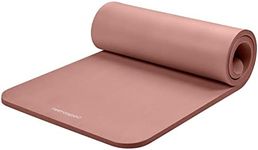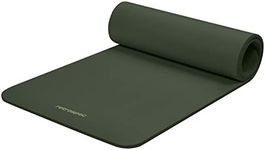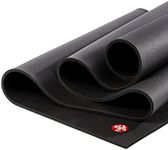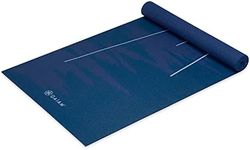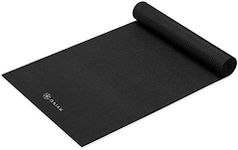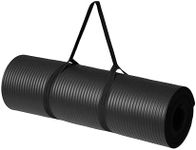Buying Guide for the Best Mens Yoga Mats
Choosing the right yoga mat is essential for a comfortable and effective practice. The right mat can provide the necessary support, cushioning, and grip to enhance your yoga experience. When selecting a yoga mat, consider your personal needs, the type of yoga you practice, and any specific preferences you might have. Here are some key specifications to help you make an informed decision.ThicknessThickness refers to how thick the yoga mat is, which affects the level of cushioning it provides. Thicker mats (around 6mm or more) offer more cushioning and are great for those who need extra support for their joints, such as beginners or those with sensitive knees. Medium thickness mats (around 4-5mm) provide a balance of cushioning and stability, suitable for most practitioners. Thinner mats (1-3mm) offer less cushioning but are more portable and provide a better connection to the ground, ideal for travel or for those who prefer a more grounded feel. Choose a thickness based on your comfort needs and the type of yoga you practice.
MaterialThe material of the yoga mat affects its durability, grip, and eco-friendliness. Common materials include PVC, TPE, natural rubber, and cork. PVC mats are durable and provide good grip but are not eco-friendly. TPE mats are more environmentally friendly and offer good cushioning and grip. Natural rubber mats are eco-friendly, provide excellent grip, and are durable, but they can be heavier and have a distinct smell. Cork mats are also eco-friendly, provide a unique texture, and have natural antimicrobial properties. Consider your priorities, such as environmental impact, grip, and durability, when choosing the material.
TextureTexture affects the mat's grip and how it feels under your hands and feet. Smooth mats provide a softer feel but may become slippery when wet. Textured mats offer better grip, especially during sweaty practices, and can help prevent slipping. The texture can be either natural, like the surface of a rubber mat, or added, like the raised patterns on some PVC mats. If you tend to sweat a lot or practice hot yoga, a textured mat might be more suitable. If you prefer a smoother surface, look for mats with a non-slip coating.
SizeYoga mats come in various sizes, with the standard size being around 68 inches long and 24 inches wide. Taller individuals may prefer longer mats (72 inches or more) to ensure they have enough space for their practice. Wider mats can provide extra room for movement and are beneficial for those who want more space. Consider your height and the type of yoga you practice when choosing the size. If you travel frequently, a smaller, more portable mat might be more convenient.
WeightThe weight of the yoga mat can affect its portability. Heavier mats (around 5 pounds or more) tend to be more durable and provide better cushioning, making them suitable for home practice. Lighter mats (around 2-4 pounds) are easier to carry and are ideal for those who travel or take their mat to different locations. Consider how often you will be transporting your mat and choose a weight that fits your lifestyle.
GripGrip is crucial for maintaining stability and preventing slipping during your practice. Mats with good grip will keep you steady in various poses, especially in more dynamic or sweaty practices. Look for mats with a non-slip surface or those made from materials known for their grip, like natural rubber or textured PVC. If you practice hot yoga or tend to sweat a lot, a mat with excellent grip is essential to prevent slipping and ensure safety.
DurabilityDurability refers to how well the mat holds up over time with regular use. More durable mats are made from high-quality materials that resist wear and tear, such as natural rubber or high-density PVC. If you practice frequently, investing in a durable mat can save you money in the long run. Consider how often you practice and choose a mat that can withstand your level of use.
Eco-friendlinessEco-friendliness is important for those who are environmentally conscious. Mats made from natural materials like rubber, cork, or jute are more sustainable and biodegradable. TPE mats are also a more eco-friendly option compared to PVC. If reducing your environmental impact is a priority, look for mats labeled as eco-friendly or made from sustainable materials.
